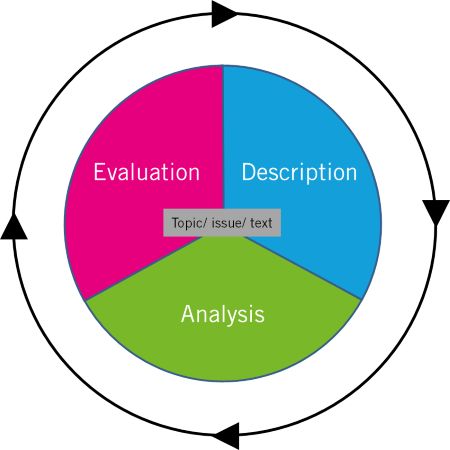Critical thinking
A model for critical thinking
Critical thinking is an important life skill, and an essential part of university studies. Central to critical thinking is asking meaningful questions.
This three-stage model, adapted from LearnHigher, will help you generate questions to understand, analyse, and evaluate something, such as an information source.
Description
Starting with the description stage, you ask questions such as: What? Where? Why? and Who? These help you establish the background and context.
For example, if you are reading a journal article, you might ask questions such as:
- Who wrote this?
- What is it about?
- When was it written?
- What is the aim of the article?
If you are thinking through a problem, you might ask:
- What is this problem about?
- Who does it involve or affect?
- When and where is this happening?
These types of questions lead to descriptive answers. Although the ability to describe something is important, to really develop your understanding and critically engage, we need to move beyond these types of questions. This moves you into the analysis stage.
Analysis
Here you will ask questions such as: How? Why? and What if? These help you to examine methods and processes, reasons and causes, and the alternative options. For example, if you are reading a journal article, you might ask:
- How was the research conducted?
- Why are these theories discussed?
- What are the alternative methods and theories?
If you are thinking through a problem, you might ask:
- What are the contributing factors to the problem?
- How might one factor impact another?
- What if one factor is removed or altered?
Asking these questions helps you to break something into parts and consider the relationship between each part, and each part to the whole. This process will help you develop more analytical answers and deeper thinking.
Evaluation
Finally, you come to the evaluation stage, where you will ask 'so what?' and 'what next?' questions to make judgments and consider the relevance; implications; significance and value of something.
You may ask questions such as:
- What do I think about this?
- How is this relevant to my assignment?
- How does this compare to other research I have read?
Making such judgments will lead you to reasonable conclusions, solutions, or recommendations.
The way we think is complex. This model is not intended to be used in a strictly linear way, or as a prescriptive set of instructions. You may move back and forth between different segments. For example, you may ask, 'what is this about?', and then move straight to, 'is this relevant to me?'
The model is intended to encourage a critically questioning approach, and can be applied to many learning scenarios at university, such as: interpreting assignment briefs; developing arguments; evaluating sources; analysing data or formulating your own questions to research an answer.
Watch the ‘Thinking Critically at University’ video for an in-depth description of a critical thinking model. The rest of our Critical thinking pages will show you how to use this model in practice.
This model has been adapted from LearnHigher under a Creative Commons BY-NC-SA 3.0.


